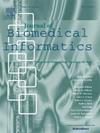上下文信息有助于生物医学命名实体的规范化。
IF 4
2区 医学
Q2 COMPUTER SCIENCE, INTERDISCIPLINARY APPLICATIONS
引用次数: 0
摘要
目的:生物医学命名实体规范化(BNEN)是生物医学信息学中最重要的上游任务之一,其目的是将命名实体映射为统一的标准标识符或术语。现有的方法大多只考虑单个提及本身与候选提及之间的相似度,而忽略了提及周围的有价值的上下文信息,这对于理解具有歧义的提及的真实语义也是非常重要的。材料与方法:本文基于具有代表性的SOTA(最先进的)BNEN方法IA-BIOSYN,提出了一种具有上下文信息融合的新型BNEN方法CIFSYN,该方法通过将给定提及的候选项置于提及的相同上下文中来综合考虑给定提及的上下文,并引入上下文信息融合模块来捕获提及、候选项和上下文之间的关系。结果:在4个公开的BNEN数据集上的实验表明,我们提出的方法在NCBI-Disease、BC5CDR-Disease、BC5CDR-Chemical和TAC2017-ADR上的准确率分别达到Acc@1,分别为0.934、0.937、0.969和0.959,明显优于现有的SOTA方法,引入上下文信息模块后,Acc@1的平均准确率提高了0.5%。结论:提及周围的上下文信息提高了生物医学命名实体规范化的性能。本文章由计算机程序翻译,如有差异,请以英文原文为准。

Contextual information contributes to biomedical named entity normalization
Objective:
As one of the most crucial upstream tasks in biomedical informatics, biomedical named entity normalization (BNEN) aims to map mentioned named entities to uniform standard identifiers or terms. Most existing methods only consider the similarity between the individual mention itself and its candidates, however, ignore the valuable information of the context around the mention, which is also very important to understand the real semantic of the mention when it is ambiguous.
Material and Methods:
In this paper, based on IA-BIOSYN, a representative SOTA (state-of-the-art) BNEN method, we propose a novel BNEN method with contextual information fusion, called CIFSYN, where the context of a given mention is comprehensively considered by putting the given mention’s candidates in the same context of the mention, and the contextual information fusion module is introduced to capture the relationship among the mention, candidates, and context.
Results:
Experiments on five public BNEN datasets show that our proposed method achieves Acc@1 of 0.934, 0.937, 0.969, 0.959, and 0.856 on NCBI-Disease, BC5CDR-Disease, BC5CDR-Chemical, TAC2017-ADR, and COMETA, respectively, significantly better than other existing SOTA methods, and the introduced context information module brings a 0.5% improvement in Acc@1 on average.
Conclusion:
Contextual information around the mention improves the performance of biomedical named entity normalization.
求助全文
通过发布文献求助,成功后即可免费获取论文全文。
去求助
来源期刊

Journal of Biomedical Informatics
医学-计算机:跨学科应用
CiteScore
8.90
自引率
6.70%
发文量
243
审稿时长
32 days
期刊介绍:
The Journal of Biomedical Informatics reflects a commitment to high-quality original research papers, reviews, and commentaries in the area of biomedical informatics methodology. Although we publish articles motivated by applications in the biomedical sciences (for example, clinical medicine, health care, population health, and translational bioinformatics), the journal emphasizes reports of new methodologies and techniques that have general applicability and that form the basis for the evolving science of biomedical informatics. Articles on medical devices; evaluations of implemented systems (including clinical trials of information technologies); or papers that provide insight into a biological process, a specific disease, or treatment options would generally be more suitable for publication in other venues. Papers on applications of signal processing and image analysis are often more suitable for biomedical engineering journals or other informatics journals, although we do publish papers that emphasize the information management and knowledge representation/modeling issues that arise in the storage and use of biological signals and images. System descriptions are welcome if they illustrate and substantiate the underlying methodology that is the principal focus of the report and an effort is made to address the generalizability and/or range of application of that methodology. Note also that, given the international nature of JBI, papers that deal with specific languages other than English, or with country-specific health systems or approaches, are acceptable for JBI only if they offer generalizable lessons that are relevant to the broad JBI readership, regardless of their country, language, culture, or health system.
 求助内容:
求助内容: 应助结果提醒方式:
应助结果提醒方式:


